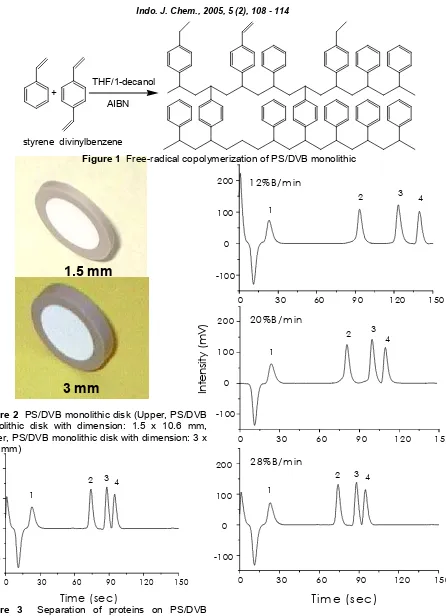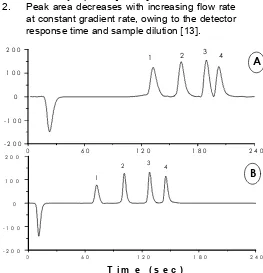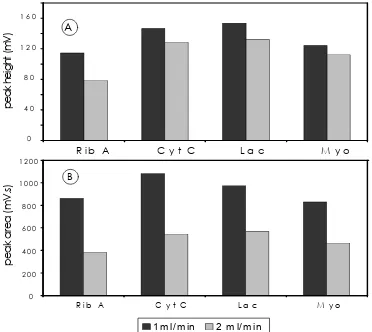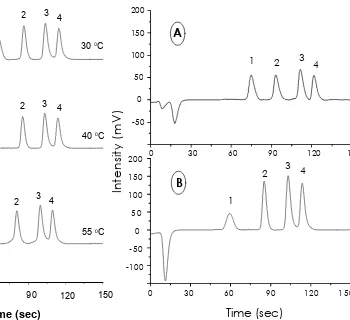* Corresponding author.
Email address : nurul.hidayat@ugm.ac.id
MONOLITHIC DISK FOR THE FAST CHROMATOGRAPHIC SEPARATION
OF PROTEINS
Nurul H. Aprilita
1,*, Rania Bakry
2, Christian W. Huck
2and Guenther. K. Bonn
21
Chemistry Department, Faculty of Mathematics and Natural Sciences, Gadjah Mada University, Sekip Utara PO.Box BLS 21, Yogyakarta, Indonesia 55281
2
Institute of Analytical Chemistry and Radiochemistry, University of Innsbruck, Innrain 52a, A-6020, Innsbruck, Austria
Received 4 April 2005; Accepted 28 April 2005
ABSTRACT
Poly(styrene/divinylbenzene) (PS/DVB) monolithic disk was prepared by in situ free-radical copolymerization of styrene and divinylbenzene in the presence of decanol and tetrahydrofuran as porogens. PS/DVB monolithic disks were produced in two different lengths 1.5 mm and 3 mm. The disks were used in reversed phase chromatography of proteins with 0.2 % trifuoroacetic acid (TFA) and 0.2 % TFA in acetonitrile as mobile phase A and B, respectively. The effect of gradient rate, flow rate, temperature and disk length on the separation of proteins were also studied. PS/DVB monolithic disks allow the rapid separation of proteins in reversed phase chromatography.
Keywords:monolithic disk, poly(styrene/divinylbenzene), proteins
INTRODUCTION
During the last seventeen years, a tremendous increase in the speed of chromatographic separations of large molecules having low mobility, such as proteins, DNA, and even viruses, can be noticed. These fast separations, with concomitant reduction in the contact time between the labile biomolecules and the surface of the stationary phase, have enabled a considerable increase in both the specific activity and yield various therapeutics. These benefits make HPLC one of the key analytical techniques requested by regulatory authorities1, 2.
Chromatography researchers continue to make improvement in chromatography packings and sorbent for biomolecules. Each generation of chromatographic sorbent has provided better efficiency and increased mechanical stability in their resistance to back pressure generated by flow. The four distinct generations of sorbent materials have been polysaccharide-based, cross-linked and coated, monodisperse and monoliths [3]. Monoliths are the fourth generation and the latest development to increase the chromatographic performance. Reversed phase HPLC on hydrophobic stationary phases is one of the most common and powerful chromatographic separation modes for proteins and peptides [4].
The speed of the separation depends on the length of the column that determines the residence time of the analyte molecules within the separation device. Since, in general, the residence times in shorter columns are shorter at the same flow velocity, the separation cycle is faster. However, such short columns must possess sufficient separation power to afford the desired resolution. Chen and Horváth [2] have shown that for proteins this could be achieved using gradient elution. Particle diameters of less than 1 µm and column lengths shorter than 1 cm were suggested to be optimal for the separation on these short columns and, therefore, this approach was not suitable for preparative work [1].
ultra-other molecules that traditionally have been separated using steep gradients, with appropriate resolution and at low gradient times. Short columns can be efficiently used for the separation of proteins and probably for other large molecules as well, especially in reversed phase chromatography5.
The major difference in the treatment of column (conventional particle-based, but also monolithic columns) chromatography in general and disk chromatography is the significance ascribed to any individual adsorption/desorption step. Multiple interactions and hence (statistical) accumulation of the effects are assumed in column chromatography. Consequently, the effect of the initial step is considered as too insignificant to deserve or require an individual evaluation. In disk chromatography, on the other hand, the separation is interpreted as one-act desorption process even in such cases where the theoretical separation layer thickness does not exactly correlate with the physical thickness of the chromatographic disk10.
This study described the preparation PS/DVB monolithic disks and their application as stationary phases for the reversed phase chromatographic separation of proteins.
EXPERIMENTAL SECTION
Materials
Ribonuclease A bovine pancreas (min. 90 %), cytochrome C equine heart (min. 95%), -lactalbumin Type I bovine milk (≥ 85 %), myoglobin equine heart (min. 90 %), 1-decanol (≥ 98 %), 1-decanol (purum) and trifluoroacetic acid 99 % (TFA) were obtained from Sigma (St. Louis, MO, USA). Acetonitrile gradient grade (≥ 99.9%), divinylbenzene (synthesis grade) and tetrahydrofuran (≥ 99.9 %) were purchased from Merck (Darmstadt, Germany). , ’ -Azoisobutyronitrile (AIBN, ≥ 98 %) was from Fluka (Buchs, Switzerland), styrene (synthesis grade) was form J.T. Baker (Deventer, Netherland) and Argon gas were from AGA (Vienna, Austria).
Styrene and divinylbenzene were distilled before use to remove inhibitor. The tetrahydrofuran (THF) used as porogen was distilled over sodium metal to remove the inhibitor 2,6-di-tert-butyl-4-methylphenol (BHT). For preparation of all aqueous solutions, high purity water (Epure, Barnstead Co., Newton, MA, USA) was used.
Procedure
Preparation of the PS/DVB monolithic disk
A mixture containing 600 µL or 546.0 mg styrene, 600 µL or 558.0 mg divinylbenzene, 1560
THF, and 30.0 mg AIBN were sonicated and purged with argon for 5 minutes. The polymerization mixture was filled to the PEEK cylinder covered with the PEEK cap (the outer diameter of the pipe is 16 mm and corresponds to that in the disk, the inner diameter of the hole is 10.6 mm and corresponds to the inner diameter the disk).
The polymerization took place in the water bath at 70oC for 24 hours and then the disk was cut in 3 mm and 1.5 mm thick. The disk was put into housing, washed with 80 % Acetonitrile for 10 minutes, in order to remove remaining monomers and porogen.
High-performance liquid chromatography
(HPLC) using PS/DVB monolithic disk
HPLC was carried out using a Merck-Hitachi pump model L-7120 controlled by a personal computer with HPLC System Manager model D-7000 software. The samples were injected through an autosampler from Merck-Hitachi L-7200, and monitor at 214 nm with an L-7400 Merck-Hitachi UV detector. The column oven was an L-7300 Merck-Hitachi.
Solutions consisting of 0.2 % TFA and 0.2 % TFA in acetonitrile were used as mobile phase A and B for the gradient elution, respectively.
RESULT AND DISCUSSION
Preparation of the PS/DVB monolithic disk
Preparation of the monolithic disk mostly involves three major steps: (i), polymerization of a monolithic material in a suitable format of sheets (membranes) or rods, (ii) cutting disks from them, and, (iii) if necessary, their chemical modification. Once the preparation of monolithic disk is completed, a short monolithic column is obtained by inserting them in an appropriate cartridge or other device [1].
PS/DVB monolithic disk was prepared by a free-radical copolymerization of styrene as a monomer with divinylbenzene as a cross-linking monomer in the presence of 1-decanol and THF as porogens and AIBN as an initiator. The reaction is illustrated in Figure 1. PS/DVB monolithic disks were produced in our group with two different lengths 1.5 mm and 3 mm (Figure 2).
1.5 mm
1.5 mm
In
te
n
si
ty
(m
V
)
0 30 60 90 120 150
-100 0 100 200
1
2 3 4
Time (sec)
+styrene divinylbenzene THF/1-decanol
AIBN
0 30 60 90 120 150
-100 0 100 200
1
2 3 4
12%B/min
0 3 0 6 0 9 0 1 2 0 1 5 0
-1 0 0 0 10 0 20 0
In
te
n
si
ty
(m
V
)
1
2 3 4 20%B/min
0 3 0 60 9 0 1 2 0 1 5 0
-1 00 0 1 0 0 2 0 0
Tim e (se c )
12 3 4 28%B/min
Figure 1 Free-radical copolymerization of PS/DVB monolithic
Figure 2 PS/DVB monolithic disk (Upper, PS/DVB monolithic disk with dimension: 1.5 x 10.6 mm, Lower, PS/DVB monolithic disk with dimension: 3 x 10.6 mm)
Figure 3 Separation of proteins on PS/DVB monolithic disk. Conditions: Disk 1.5 x 10.6 mm I.D.; mobile phase A = 0.2% aqueous TFA, B = 0.2% TFA in acetonitrile; gradient 80-10% A in 2.5 minutes, flow rate, 2 mL/min; detection UV, 214 nm; temperature, 55o C, injection volume, 5 µL, sample :1=ribonuclease A, 2=cytochrome C, 3= -lactalbumin and 4=myoglobin.
Figure 4 The effect of varying gradient-rate on separation of proteins using PS/DVB monolithic disk. Conditions: Disk 1.5 x 10.6 mm I.D.; mobile phase A = 0.2% aqueous TFA, B = 0.2% TFA in acetonitrile; flow rate, 2 mL/min; detection UV, 214 nm; temperature, 55oC, injection volume, 5 µL.
1
Figure 4 demonstrates the effect of varying gradient-rate on the separation of proteins using a monolithic disk. An indirect correlation between retention times and increase of the gradient rate from 12% B/min to 28% B/min is evident. However a good separation can still be achieved with the highest gradient-rate (28% B/min), although resolution value are lower (Figure 5).
The effect of flow rate on sensitivity and resolution of proteins
Figure 6 shows the separations of proteins obtained at different flow rate, i.e. 1 mL/min (A) and 2 ml/min (B) at a constant gradient-rate of 12.5% B/min. As expectable, a higher flow rate shortens
Figure 5 Dependence of resolution between standard proteins on gradient-rate. Column and conditions are the same as described in Figure 4.
retention time for protein 1 (ribonuclease A) is 133.2 and 72 seconds at flow rate 1 and 2 mL/min, respectively. Surprisingly, peak shape and as a consequence of that also resolution was improved, owing to lower longitudinal diffusion (Table 1). On the other side, the difference in retention time between protein peaks is independent on the flow rate.
The effect of flow rate on peak height and area of proteins are illustrated graphically in Figure 7 A and B respectively. From this figure, it can be summarized as follows:
1. Peak height increases with decreasing flow rate at constant gradient rate of 12.5% B/min, as already reported11, 12.
2. Peak area decreases with increasing flow rate at constant gradient rate, owing to the detector response time and sample dilution13.
Figure 6 Effect of the flow rate to the separation of protein on PS/DVB monolithic disk (A; 1 mL/min, and B; 2 mL/min). Conditions: Disk 1.5 x 10.6 mm I.D.; mobile phase: A = 0.2% aqueous TFA, B = 0.2% TFA in acetonitrile, gradient: 80-30% A in 4 min; detection UV, 214 nm; temperature, 30oC
Table 1 Effect of flow rate on the resolution of proteins using PS/DVB monolithic disk Resolution (R)
Flow rate (mL/min)
0 4 0 8 0 1 2 0 1 6 0
R i b A C y t C L a c M y o
p
e
a
k
h
e
ig
h
t
(m
V
)
0 2 0 0 4 0 0 6 0 0 8 0 0 1 0 0 0 1 2 0 0
R ib A C y t C L a c M y o
p
e
a
k
a
re
a
(m
V
.s
)
A
B
1 m l/m in 2 m l/m in
Figure 7 Graphical representation of effect flow rate on sensitivity of peak detection in reversed phase chromatography of proteins. Effect of flow rate on peak height of proteins (A) and peak area of proteins (B). Column and conditions are the same as described in figure 6.
Table 2 Influence of the temperature to the separation of proteins on PS/DVB monolithic disk Temperature (oC)
Ret. time (sec) 30 40 55
ribonuclease A 66.0 59.4 23.4
cytochrome C 86.4 85.5 81.0
-lactalbumin 103.8 103.2 99.6
myoglobin 114.6 114.0 109.8
The effect of temperature on proteins separation using monolithic disks
The effect of temperature on the separation of proteins using monolithic disks was studied in the range of 30o C, 40o C and 55oC (figure 8). It can be seen from figure 8 that increasing the temperature will shorten the retention time of the proteins, mainly ribonuclease A, accelerated from 66 seconds to 23.4 seconds retention time (Table 2).This data agree with already published investigation on conventional RP-HPLC, where a general reduction in protein or peptide retention time with increasing temperature was shown, due
to increasing solubility of the solute in the mobile phase [14, 15].
The effect of disk length
In
Figure 8 Influence of the temperature on the separation of proteins using a PS/DVB monolithic disk. Conditions: Disk, monolithic (1.5 x 10.6 mm I.D); mobile phase A = 0.2% aqueous TFA, B = 0.2% TFA in acetonitrile; gradient, 80-30% A in 2.5 min; detection UV, 214 nm; flow rate, 2 mL/min.
Figure 9 Separation of (1) ribonuclease A, (2) cytochrome C, (3) -lactalbumin and (4) myoglobin on PS/DVB monolithic disk (A) 3 x 10.6 mm I.D. and (B) 1.5 x 10.6 mm I.D. Conditions: mobile phase A: 0.2% TFA in water, B: 0.2% TFA in acetonitrile; gradient, 80-30% A in 2.5 min, flow rate, 2 mL/min, detection, UV 214 nm, temperature, 40oC, injection volume, 5 µL.
Table 3 The effect of disk length to the retention factor (k) k
Protein
1.5 x 10.6 mm I.D. 3 x 10.6 mm I.D.
ribonuclease A 4.21 7.93
cytochrome C 6.47 10.07
-lactalbumin 8.05 12.29
myoglobin 9.00 13.50
ribonuclease A is 59.4 seconds for 1.5 mm disk and 76.8 seconds for 3 mm disk (Figure 9). With the shorter length, separation times may decrease somewhat due to the smaller void volume, but under the slow gradient rates, which gave the best resolution; this difference becomes negligible [17]. However, the retention factor (k) is higher at least 1.5 times when using 3 mm disk than 1.5 mm disk (Table 3). In general, shorter disk is favored in term of fast separation of proteins.
CONCLUSION
ACKNOWLEDGEMENT
Technology Grant Southeast Asia scholarship from The Austrian Federal Ministry for Education, Science and Culture to Nurul Hidayat Aprilita is gratefully acknowledged.
REFFERENCES
1. Barut, M., Podgornik, A., Merhar, M., and Strancar, A., 2003,J.Chromatogr.Lib.,67, 51 2. Chen, H., and Horváth, C., 1995, J.
Chromatogr. A.,705, 3
3. Iberer, G., Hahn, R., and Jungbauer, A., 1999, LC.GC, 17, 998
4. Hearn, M.T.W., 1991, HPLC of Proteins, Peptides and Polynucleotides, VCH Publisher, Inc
5. Strancar, A., Podgornik, A., Barut, M., and Necina, R., 2002, Adv. Biochem Eng/Biotechnol, 76, 49
6. Abou-Rebyeh, H., Körber, F., Schubert-Rehgberg, K., Reusch, J., and Josic, D., 1991, J. Chromatogr., 566, 341
7. Josic, D., Reusch, J., Löster, K., Baum, O., and Reutter, W., 1992,J. Chromatogr. A., 590, 59
8. Belenkii, B.G., Podkladenko, A.M., Kurenbin, O.I., Mal’tsev, V.G., Nasledov, D.G., and Trushin, S.A., 1993, J. Chromatogr. A., 645, 1 9. Dubinina, N.I., Kurenbin O.I., and Tennikova,
T.B., 1996,J. Chromatogr. A., 753, 217
10. Tennikova T.B., and Freitag, R., 2000, J. High Resol. Chromatogr., 23, 27
11. Burke, T.W.L., Mant, C.T., and Hodges, R.S., 1991, The Effect of Varying Flow-Rate, Gradient-Rate, and Detection Wavelength on Peptide Elution Profiles in Reversed-Phase Chromatography in High- Performance Liquid Chromatography of Peptides and Proteins (Mant C.T., and Hodges, R.S., edt.), CRC press, Boca Raton
12. Schlabach, T.D., and Wilson, K.J., 1987, J. Chromatogr., 385, 65
13. Meek, J.L., and Rossetti, Z.L., 1981, J. Chromatogr., 211, 15
14. Guo, D., Mant, C.T., Taneja, A.K., and Hodges, R.S., 1986,J. Chromatogr., 359, 519
15. Antia, F.D., and Horvárth, C., 1988, J. Chromatogr., 435, 1
16. Snyder, L.R., Stadalius, M., and Quarry, M.A., 1983,Anal. Chem., 55, 1412A



